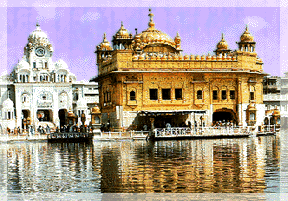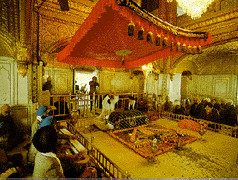Discover Amritsar
Description: Amritsar is the soul of Punjab - the holy city of Sikhs, has grown from a sacred village pond into a spiritual temporal centre of Sikh culture. The city gets its name from the pool-Amritsar (Pool of Nectar), which was constructed by the fourth religious preceptor of the Sikh faith. It also lies on the Asian Highway. Amritsar is the home of traditional Punjabi cuisine, both vegetarian and non-vegetarian where each eating-house has a specialty, which can not be matched. Its pickles, murabbas (Indian jams) and papads and warian (recipes can not be translated into English) and sweetmeats are exported to far off places, right into Punjabi Diaspora abroad.Located as it is on the Indo-Pak Border, Amritsar is the most vulnerable and hence was most targeted town during the Indo-Pakistan war. So in both the Indo-Pak wars (i.e. in 1965 and 1972), Amritsar acted as shield for the rest of India, bearing all the burns. Fortunately it proved its mettle and not only escaped physical damage but also keep its industry and economy steadfast. The Amritsaries are sweet spoken and God fearing people. They are fond of good dress, good food and sophisticated living. Lot of fashion, fun and festivities are visible every day. History: The globally renown Golden Temple, Harmandir Sahib, which enshrines the Holy Book of the Sikhs, the Guru Granth Sahib, is located in Amritsar. Amritsar, literally 'a pool of nectar', was founded by the fourth Guru of Sikhs, Guru Ram Das, who had initially constructed a pool here. The vital nucleus of Sikhism, Amritsar is also believed to be the site, where Sage Valmiki wrote the epic, Ramayana. According to popular belief, Rama and Sita had spent a brief period of their 14 year exile here. The construction of the temple was completed in late sixteenth century. It was rebuilt by the Sikh ruler, Maharaja Ranjit Singh in 1803. The Golden Temple is a two storey marble structure, with an imposing dome of pure gold. The architecture of the Golden Temple, is a blend of Hindu and Muslim styles. The golden dome is meant to represent an inverted lotus flower. The interior of the temple is decorated with semi precious stones, frescoes and glass work. The Akal Takht, or immortal throne, established by the sixth Sikh Guru, Guru Hargobind, is the supreme seat of Sikh religious authority, and is also the repository of ancient weapons, used by the Sikh warriors and Gurus. The original copy of the Granth Sahib, which is kept in the Golden Temple during the day, is ceremoniously returned to the Akal Takht, at night. It stands there in simple majesty, the gilded splendor of its paneling, dome and minarets shining in the morning light, silhouetted softly in the water and etched gently across the city escape. For the Sikh community the Harmandir Sahib Gurdwara Golden Temple is the final spiritual “vision,” journey’s end or beginning and, for every other community too, it is a shrine to be visited. The Golden Temple in Amritsar is the most exalted of all Sikh shrines, drawing pilgrims from near and far for centuries. The temple’s story began some four centuries ago when the third Sikh Guru Amar Das asked Guru Ram Das (who succeeded him) to build a central place for the congregation of the Sikhs. Guru Arjan Dev completed the work started by Guru Ram Das in the 16th century. The gurdwara has four entrance doors, called deoris, in all four directions—symbolic of the new faith that made no distinction between caste and creed. People could enter and bow in any direction they preferred. The Amrit Sarovar or pool of nectar had long been associated with Indian legends and Lord Rama’s twin sons had supposedly been taught the Ramayana here. How the land was acquired for the construction of the temple has many stories. Some say the Guru bought it, others say it was granted by emperor Akbar. Whatever the story, it is certain it was revenue free land. Oral tradition dictates that the Muslim divine Pir Mian Mir of Lahore, at the request of the fifth Sikh Guru Arjan Dev, laid the temple’s foundation stone. However, there is no record supporting this, not even in the biographies of Pir. The recorded account says that Guru Arjun Dev laid the foundation in 1588. The Guru’s followers settled down in the neighborhood and a small town called Ramdaspur quickly came up, deriving its later name, Amritsar, from the holy tank that encircles the Hari Mandir, or the Darbar Sahib, now known as the Golden Temple. The flourishing town that grew around the temple during Guru Arjan Dev’s lifetime grew further in stature as the followers of Sikhism grew in number. Things moved fast. The first Sikh Maharaja, Ranjit Singh, made Amritsar his spiritual capital while Lahore was the temporal seat of his newly founded expanding kingdom. Ranjit Singh oversaw the temple’s further development, gilding the embossed plates, renewing the pietra dura and embellishing the interior with floral designed, mirrored ceilings. The Golden Temple is an eclectic monument that has grown as much of people’s devotion as from the guild craftsmen’s skills. Generation after generation has lavished praise on the art and architecture of the golden temple and it is widely regarded as being amongst the most tastefully decorated shrines anywhere.As one descends into the temple (unlike most temples, here one actually descends as the structure is built below the level of the surrounding area), one is confronted by the stunningly beautiful sanctum sanctorum glimmering in the water of the holy tank that is flanked on all four sides by spotlessly clean marble walkways and pavements.The main structure rises from the center of the sacred pool and is approached by a long causeway. The 52-meter, square-based Hari Mandir stands on a square platform, its lower parts marble, and its upper portion fully covered with plates of gilded copper. In the interior, on the ground, the Guru Granth Sahib (holy book of the Sikhs) is placed under a jewel-studded canopy. On the first floor is a small pavilion called the Shish Mahal (mirror room). It is ornamented with pieces of mirrors inlaid in the ceiling and walls. Above is another smaller pavilion. Exquisite murals adorn the walls of the pavilions, but other than that, the emphasis is on simplicity. Situated at the other end of the causeway connected to the Harmandir Sahib is the Akal Takht. Literally, it means the eternal throne and its building opposite the temple has a significance. While the temple stands for the spiritual guidance, the Akal Takht symbolizes the dispensing of justice and temporal activities. During the day, the Guru Granth Sahib is kept in the temple and at night at the Akal Takht. Traditionally all Sikh warriors sought blessings here before going for war.As it has done for several centuries, the temple mirrors many images that are dear to the devout. One sees the beautiful golden dome shimmering in the water. One sees thousands of devotees praying and kneeling before the holy book. One sees them touch the holy water and pour it over their foreheads. One sees people streaming into the langar hall to partake of the common meal served lovingly to all. Forming a soothing and beautiful soundtrack to all these activities is the continuous kirtan (devotional) recitation that has provided solace to so many. The Temple interior
The gnarled old Jubi Tree in the north west corner of the compound, is believed to possess special powers. It was planted 450 years ago, by the Golden Temple's first high priest, Baba Buddhaya. Guru-ka-Langar or the communal canteen, is towards the eastern entrance of the temple complex, and it provides free food to all visitors, regardless of colour, creed, caste or gender. Pilgrims and visitors to the Golden Temple, must remove their shoes and cover their heads, before entering the temple premises. The best time to visit the temple is early in the morning, on weekdays, before it gets crowded. EXCURSIONS: Near the Golden Temple, is Jallianwala Bagh, a poignant memorial of the Freedom Movement. The 2000 Indians killed and wounded here in the indiscriminate firing by the British on Baisakhi in 1919 (April 13, 1919) this garden was the site of a brutal massacre of over 2000 innocent unarmed people, on the orders of a British General .The carnage had nationwide ramifications, shaking and enraging the whole country. The bullet scarred walls of the well kept garden, today, enclose a memorial with an eternal flame, dedicated to the martyrs. Durgiana Temple, outside the Lohagarh gate of the old city, is dedicated to Goddess Durga, and is a centre of pilgrimage for devout Hindus. Other attractions are Ram Bagh Garden, encircling the palace of the Sikh ruler Ranjit Singh; Fort Gobind Garh, which was built by Ranjit Singh in 1805-09; Baba Atal Rai Tower; Baba Bakale, a gurudwara dedicated to Tegh Bahadur, the ninth Guru of Sikhs and Taran Taran, a gurudwara in the memory of Guru Ram Das. Within an hour’s drive
from Amritsar are several interesting places to visit. Several historical
Gurdwaras like Baba Bakala, Goindwal Sahib, Tarn Taran, and Bir Baba
Budha Sahib,
attract the devout. The drive takes one through the heart of rural
Punjab with lush green paddy fields, tiny villages, and robust farmers.
A popular outing is to the Wagah
checkpost on the Indo-Pakistan border where crowds throng to see the
change of guards ceremony and the flag hoisting and lowering, all
done with great skill and precision.
Cities Around:
Amritsar is connected by bus with Ambala, Chandigarh, Delhi, Ferozepur, Jammu etc. Some of the road distances are as follows:- Jammu 216 kms, Ferozepur 160 kms, Chandigarh 235 kms, Delhi 435 kms and Wagah 29 kms.
To get to Amritsar
Browse...... ACCOMMODATION: MK hotel in the Ranjit Avenue area is the finest hotel with world class ambience. The Ritz Hotel was one of the first hotels in the city. It is being renovated and expanded. Punjab Tourism runs an air-conditioned Amritsar International Hotel. Mohan International Hotel is also air-conditioned. There are many hotels near to the railway station and on the Queens Road. Gurdwaras offer free accommodation to all pilgrims. Where to stay: We recommend some places to stay so browse the web-Page.......here When to visit: The best time to visit Amritsar is between October and March. Temperature (deg C): Summer- Max. 34, Min. 15; Winter- Max. 18, Min. 0 . Rainfall : 59.2 cms Getting Around the City: Cycle Rickshaws, Taxis, City buses. Tourist Information Centers: Tourist Bureau, Government of Punjab, Palace Hotel, Opposite Railway Station, and one also at the Youth Hostel (Tele #2231452),1k.m East to Bus station, and fairly helpful. It is open from through Monday to Saturday and Timing's are 9 am to 3 pm. The Information Office in Golden Temple remains open daily, the Timing's are 8 am to 1 pm & 2.30 pm to 8 pm and the Staff is very helpful. You can also contact the SGPC information counter just outside the main Entrance of Railway station for information and free bus service to Golden Temple. Festivals: Diwali, Baisakhi, Basant and Gurparabs are the main festivals celebrated in Amritsar.
|
|||||||||||

